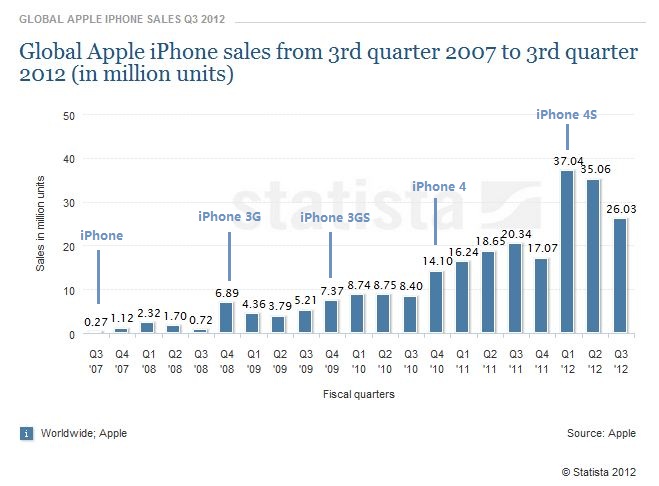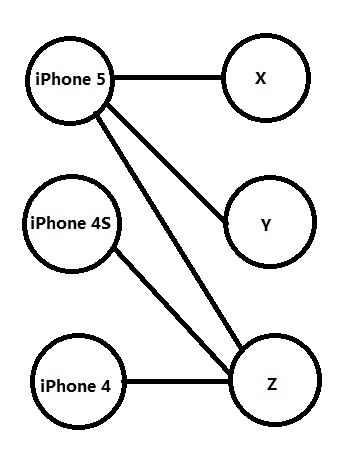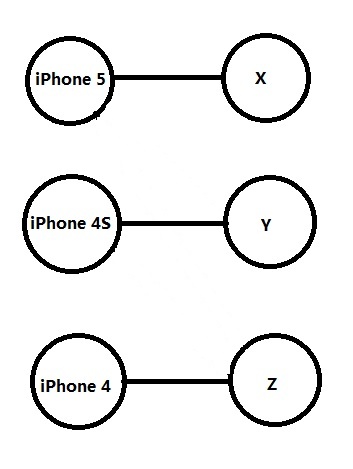iPhone Selling and Matching Strategy
With the most recent iPhone 5 released, Apple started another round of record breaking; it took more than 2 million pre-orders in the first 24 hours (1). As for the old models, Apple will also start selling unlocked and refurbished iPhones to increase its selling or maintain the sales each quarter (2). And each time, with a new version being released, Apple will lower the price of previous versions of iPhones. And the price was lowered as usual this year; iPhone 4S drops to $99, and iPhone 4 starts from $0. With a price-competitive strategy applied, the old iPhones can still take part of the market share, and appeal some customers who don’t have a strong preference to iPhone 5. This strategy is similar to the perfect matching and preferred-seller graph we talked in class.
A model with equal-sized sets of sellers and buyers is created for the analysis. There are 3 sellers – iPhone 5, iPhone 4S and iPhone 4. There are also 3 buyers defined here – customer X, customer Y and customer Z. I chose three typical types of customer here — X is a zealot of Apple products and he plans to order an iPhone 5. He takes many new features of iPhone 5 into consideration — iPhone 5 has a pair of new designed earphones, a larger screen, lightening and a faster A6 chip. So X has a much higher value of iPhone 5 than the other two models. Y thinks there is not much difference between iPhone 5 and iPhone 4S, but she would like to get the newest model of iPhone. So Y has a slightly lower value for iPhone 4S. Z is somewhat neutral to all the iPhone models; he thinks there is nothing different as long as he gets a smartphone. So Z has equal values of the models. A table is created for future analysis.
From the table, X and Y will choose to order iPhone 5 because they both have the highest value for it. Z will choose any iPhone model. The preferred-seller graph is generated and shown below:
In this case, sellers and buyers are not perfectly matched, meaning that iPhone 4S and iPhone 4 will easily lose the market when iPhone 5 is on. In order to pursue a better matching, Apple sets the price of the models as the follows: iPhone 5 starts from $199, iPhone 4S starts from $99, and iPhone 4 starts from $0 (3). We add the prices into our table and deduct the price from customers’ value and the table becomes:
In this case, the market reaches a perfect matching situation – X-iPhone 5, Y-iPhone 4S, and Z-iPhone 4. The preferred-seller graph becomes:
With the price added, X still prefers iPhone 5 because his value of iPhone maintains higher than the other two models. Y is shifting from iPhone 5 to iPhone 4S as she didn’t differentiate these two models too much at the beginning. So she is easily promoted to buy iPhone 4S. Z had no difference to all the models at the beginning, so he will definitely switch to iPhone 4 because he only wants to get a smartphone, and iPhone 4 is the cheapest model. We can see that the sellers and buyers are perfectly matched. And the price set is a market-clearing price set in this case.
A new model release will cause value changes to products, which will affect sales. With a market-clearing price set, Apple is gaining all the customers, which ensures that all the iPhone models will have some market share, and satisfy the needs of all the customers. It is a great sample of matching strategies with the use of market-clearing price.
-Open.C.W
Sources:
1).http://money.cnn.com/2012/09/21/technology/iphone-5-release/index.html
2).http://www.statista.com/statistics/12743/worldwide-apple-iphone-sales-since-3rd-quarter-2007
3).http://store.apple.com/us/browse/home/shop_iphone/family/iphone






A new model release will cause value changes to products, which will affect sales. With a market-clearing price set, Apple is gaining all the customers, which ensures that all the iPhone models will have some market share, and satisfy the needs of all the customers. It is a great sample of matching strategies with the use of market-clearing price.